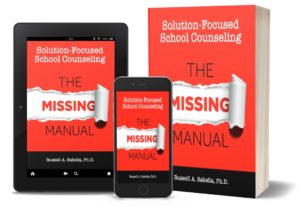 Solution-Focused Scaling
Solution-Focused Scaling
Excerpted from Sabella, R. A. (2020). Solution-focused school counseling: The missing manual. Sabella & Associates, LLC.
____________________________________________
Scaling
Scaling begins when we invite students to perceive their current situation along a continuum. In a nutshell, the process of scaling involves rating how students are currently doing on a scale from 1 (when things have been at their worst) to 10 (when their problems are resolved, and they are adequately back on track). After rating themselves, the student and counselor explore in-depth the progress that has already been made. Finally, when the time is right, the counselor then helps the student explore future progress when things are 10% better, more closely approaching their miracle.
Perhaps one of the most important advantages of solution-focused scaling is that it highlights fluctuations, helping students to more easily explore the details of their better days (or hours, or minutes). Other advantages of solution-focused scaling include that it:
- Provides a baseline of how the student is doing;
- Sets the stage for exploring progress already made (exceptions and solutions);
- Can be an excellent way to initiate the counseling process when you, as the counselor, don’t know what else to do. Scaling is especially useful to get students to open up when they are not thrilled to be in counseling, especially when you present it as a game or experiment;
- Helps students “step outside” their experience for a while, getting a bird’s-eye view of their status;
- Is easy for students to follow. In fact, after doing it several times with the counselor, students often begin scaling on their own without any prompting;
- Helps in establishing manageable, realistic, and achievable (small) steps in the counseling process; and
- Coupled with play techniques, scaling can be grasped by younger children, students with developmental challenges, and others who need to be concrete or logical.
Now, let’s look at solution-focused scaling in more detail, as a part of a three-step process.
Step 1: Present the scale and ask for a number. The counselor begins by describing a scale from 1-10, where each number represents a rating of the student’s progress toward problem resolution. For this step, you can use different types of scaling tools. You can simply draw a line on a piece of paper and make hash marks indicating placeholders for each number. Or, you can be more creative and use ladders, yardsticks, thermometers, football gridirons, or bar charts, for example (refer to this website to download various SFBC scaling templates: http://schoolcounselor.com/handouts/ or directly at http://bit.ly/sfbc-scales).
The counselor might say, “On a scale of 1 to 10, with 1 being the worst this problem has ever been, and 10 being the best things could be, what number would you give me that lets me know how you are doing right now?” Although I have emphasized the importance of being detailed when it comes to establishing goals, this time, we present the scale as a way to look at general progress. Notice that in the presenting question, we asked about “… how are you doing right now?” We did not ask about rating specific behaviors, goals, or actions. In my experience, the student may want further clarification and ask questions like, “What do you mean, like, give you a number for how I’m getting into trouble?” Again, you can (and should) keep it general at this step and reiterate, “… just a number that lets me know how things are going here at school (or at home).”
If you believe that the student’s number is inaccurate, especially if it is too high for the current reality, simply accept it as if it were true. The number they give you is not too important. The number is really a placeholder that helps to provide a baseline, focus, and motivation to progress. Movement on the scale is more important than where they start on the scale. Even if they overestimated their place on the scale by a longshot, it’s okay. If they can explain why they gave themselves a high number, they are more apt to move toward that high number in reality. So, allow them to “shoot for the stars and land on the moon.” This is more effective than challenging the student about his or her skewed perceptions and alleged distortion of reality. Remember, this is their reality.
Step 2: Explore progress already made. This step, in my opinion, is the most essential step in the solution-focused scaling process. But many counselors tend to give this step only a nod or skip it altogether. Once the student gives you a number, let’s say a 3, many counselors feel the urge to have the student explain the obvious—what is the nature of their problems and issues that must exist because they are only at a 3. Or, the counselor skips this step and wants to explore future progress at a four or higher immediately. By doing this, they rob the student of the considerable benefit derived from focusing, in detail, on the strengths, efforts, resources, and achievements already in play. Students usually report that they feel more hopeful and empowered during this time of inventorying “what is right” as compared to what is wrong. For example, if the student chooses a 3, the process is just beginning, and it is time for detailing, mind mapping, minefielding, cheerleading, amplifying, and reframing when necessary. After a student gives me their number, my favorite word to use is already (e.g., “Wow, so you are already at a 3!”) Remember, when a student reports that they are already at a 3, they are 30% on their way!
A frequent question I get is, “If you included the number zero in your scale and the student chooses it, how would you handle that?” Good question. Here are a few ideas:
- Acknowledge and then solicit a number that describes a time when he or she was doing better and focus on that number. You can ask, “What number would you give yourself when you were better or at your best?”
- Or, you can share your amazement about how they have been able to do so much already (e.g., comb their hair, get dressed, get out of bed, agree to go to school/work, meet with the counselor, etc.), all at a zero!
- You can certainly challenge it. Let the student know that, although they believe that they are at a zero, you have noticed them achieving and succeeding. Of course, you’ll need to be ready with specific examples which might be provided by their teachers or parents.
As a side note, you might consider not including zero in your scale and, instead, start at a 1. You’ll have an easier time exploring some progress at a one and not have to deal with zero, a bit of hedging on your bet. Besides, starting at a 1 is fair as there are always exceptions to problems and issues.
Step 3: Explore future progress. After you have sufficiently explored what progress your student has made, you can begin to explore future growth. In the third step, ask, “What will you be doing better or different when you get to the next number (or 10% higher)?” The key to this step is to assume that the student will indeed be making future progress. We are not asking them, “What can you do if ….?” We are asking, “What will you do when …?” You can remember this by reminding yourself that “Where there is a will, there is a way.” Your job is to help them identify what that progress looks like, describing in detail their behavior at the next number. Remember, always emphasize behaviors, thoughts, and feelings that they can control and that we can observe. Reframe actions that they want to do less. Throughout scaling, “we aim for small changes that will represent progress in the direction of goals and preferred outcomes” (Bertolino & O’Hanlon, 2002, p. 4). Ask questions such as:
- If I were to make a video recording of you when you are at a 4 (the next number on the scale), what will I see you doing that lets me know that I should start recording?
- What will others (teachers, parents, friends) see you doing that lets them know you are now at a 4?
- How will your life be better for you when you are at a 4?
- What will others (teacher, parents, friends) say or do when they notice you getting better? How does that make a difference to you?
If the student decided that he is at a 10, although you believe further progress is needed, you can continue the process by simply asking, “What would you say you will be doing better or differently if the scale went to an 11?” Don’t worry, it’s your scale; you can change it if you want. To finish, decide together on 2 to 3 behaviors that the student will be doing more or differently when 10% progress is made. The behaviors may include already existing behaviors that the student will do more of, old behaviors not currently practiced, or new behaviors or skills developed in the course of counseling or classroom lessons. These will become the goals. As a reminder, make certain that each goal meets the criteria for well-established goals: in their control, in the presence of an action (positive), and very detailed and clear.
In addition to scaling with a young student, you may choose to simultaneously scale with an adult such as a teacher or parent. If the student agrees, ask the teacher, for instance, to provide a number that indicates their perception of how the child is doing. If the teacher’s number is lower than the student’s, ask the student, “What are you doing that, if your teacher were to better notice, she too would give you a higher number? How will you be doing this better so that your teacher will notice?” If the teacher’s number is higher than the student’s, ask, “What is the teacher noticing about you that you probably have not recognized for yourself?” The focus should always be on what the student wants more frequently, more intensely, or over a longer duration.
As you may have already noticed, solution-focused scaling is very different than other types of scales that we use in counseling. SF scaling is not based on normative standards, is not supposed to be interpreted, and is certainly not a valid or reliable measure of anything outside of the student’s world. One student’s 5 is probably not another student’s 5. I’ll say it one more time: SF scaling is only for facilitating the SF process, helping students (a) better focus on what is important, (b) establish direction; and (c) generate momentum. Solution-focused scales also allow both the counselor and student to use natural dialogue by developing an agreed upon point (i.e., 6) and a concept (i.e., on a scale where 10 stands for the solution and 1 for the starting point, 6 is clearly better than 5). Scaling questions allow both counselor and student to jointly construct a bridge, a way of talking about things that may be hard to describe—including progress toward the student’s solutions (de Shazer, 1994).
References
Bertolino, B., & O’Hanlon, W. H. (2002). Collaborative, competency-based counseling and therapy. Prentice Hall.
de Shazer, S. (1994). Words were originally magic. W.W. Norton & Company.
 Get your copy today!
Get your copy today!
https://schoolcounselor.com/professional-development/themissingmanual/
 Dr. Russell A. Sabella is currently a Professor in the Department of Counseling in the College of Education, Florida Gulf Coast University and President of Sabella & Associates.
Dr. Russell A. Sabella is currently a Professor in the Department of Counseling in the College of Education, Florida Gulf Coast University and President of Sabella & Associates.